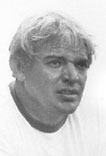 Elmer Trett’s name became synonymous with Top Fuel motorcycle drag racing during the 1970s, 1980s and 1990s. For the better part of 30 years, he showed incredible innovation and ability in making fuel-burning motorcycles perform. During his career, Trett was the driving force behind Top Fuel motorcycle racing, both as a racer and a builder of popular performance parts. He was the first motorcycle drag racer to break the 200 mph barrier in sanctioned competition.
Elmer Trett’s name became synonymous with Top Fuel motorcycle drag racing during the 1970s, 1980s and 1990s. For the better part of 30 years, he showed incredible innovation and ability in making fuel-burning motorcycles perform. During his career, Trett was the driving force behind Top Fuel motorcycle racing, both as a racer and a builder of popular performance parts. He was the first motorcycle drag racer to break the 200 mph barrier in sanctioned competition.
So significant was Trett’s contribution to the sport that the NHRA named Trett one of its 50 Top Drivers of All Time. While Trett's racing career spanned three times that of most racers, he died tragically at the NHRA U.S. Nationals in Indianapolis on September 1, 1996, while making an exhibition run, one of his numerous endeavors to bring more attention to motorcycle drag racing. He was 53.
Born in Keavy, Kentucky on March 14, 1943, Trett started drag racing in the late 1960s at Thornhill Dragway in Kenton, Kentucky. His first racing machine was his Harley-Davidson street bike. Trett owned a motorcycle performance shop in Hamilton, Ohio, and worked primarily on Harley-Davidsons. His family was always a big part of his racing, with his wife, Jackie, and daughters, Gina and Kelly, heavily involved in the family business. In the early part of the '70s, a magazine that featured a double-engined Harley inspired him and he built one and started his professional racing career.
He turned to Top Fuel in 1976 with the twin-engined Sportster. The development of the Harley reached its pinnacle in 1979 when he won his first title with sanctioning body DRAGBIKE. Lighter designs were beginning to eclipse Trett’s 900-pound, double-engined monster, so in 1980 Trett got backing from Harley-Davidson to develop a blown, single-engine nitromethane-burning V-twin. Unfortunately for Trett, Harley-Davidson was going through financial difficulties and was forced the next year to cut most of its racing programs, including Trett’s. Without the factory support, Trett had to make the difficult decision to switch to the more modern designs of the Japanese multi-cylinder machines. He chose Kawasaki.
“Nobody in my family was happy about it at first,” Trett said of his move from Harley-Davidson to Kawasaki. “But when I started racing it, I ran it soft and it wasn’t going through any parts and didn’t require any major work between rounds, so they gradually started warming up to the new bike.”
It was during this period that the Tretts, seeking a little warmer climate, moved the race shop and their home to the mountain community of Demorest, Georgia.
Trett permanently etched his name in the drag racing record books when he became the first motorcycle drag racer to eclipse 200 mph after being clocked at 201.43 at the NHRA U.S. Nationals in Indianapolis in 1983. The 200 mph barrier was the most coveted milestone in motorcycle drag racing during this era and Trett became an instant celebrity in the motorcycling community for making the hurdle. He became one of the best-known racers in motorcycling and was featured on the covers of nearly all the top motorcycling magazines.
In a 1986 feature in Motorcyclist, Trett described the sensation of riding a Top Fuel motorcycle dragster - perhaps the most treacherous contraption in all of motorsports. “Making a pass on a top fueler is like being shot out of a rifle,” Trett said. “If your aim isn’t perfect, you’re going to miss the target.” He went on to explain that the bike consumed over three gallons of nitro/alcohol mixed fuel during its seven-second run.
Throughout the 1980s and '90s, Trett refined a series of motorcycles and continued to set records along the way. In all, he won eight national Top Fuel championships under three different sanctioning bodies.
Later in his career, Trett did everything he could to keep Top Fuel motorcycle drag racing alive. He took it upon himself to talk to riders in other classes and gave them a helping hand if they made the jump to the Top Fuel. Often this meant helping an archrival that he would have to race against, but Trett worked unselfishly for the benefit of the class of drag racing he loved so much.
He was well on his way to a ninth title when he lost his life in the exhibition run. His death came when Trett was on the verge of becoming the first rider to break into the magical five-second bracket.
“He had made several record runs in the low sixes and most people believe he would have broken into the fives by the end of that year (1996),” said Keith Kizer, president of AMA Prostar.
At the time of his untimely death Trett held the 10 fastest speeds ever on a Top Fuel bike. He was the first to pass the 200, 210, 220 and 230 mph marks, and he held the record for three of the fastest elapsed times in Top Fuel. Perhaps equally as impressive as his records was his three decades at or near the top of the sport. One writer said the legend of Trett was in his longevity.
In addition to his induction into the Motorcycle Hall of Fame, Trett also became the first motorcycle racer to be inducted into the International Drag Racing Hall of Fame.